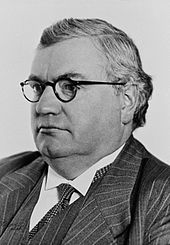Fritz Fischer (electrical engineer)
Fritz Fischer (born February 9, 1898 in Signau , † December 28, 1947 in Zurich ) was a Swiss electrical engineer . He had been married to Maud Schätti since July 30, 1936.
Fischer studied electrical engineering at the ETH Zurich from 1917 to 1924 and completed his studies with a dissertation on theoretical studies of high-value resistors for measuring purposes in high-voltage alternating current technology . In 1924/25 he improved the quality of voice transmissions at the Albisrieden telephone works , whereupon he was appointed to the central laboratory of the parent company Siemens & Halske in Berlin. There he created, among other things, the first remote-controlled ships and airplanes and researched the physical principles of color film . From 1928 he was a member of the management of the central laboratory. During this time he was also a lecturer at the Technical University of Berlin .
In 1932 he accepted a position at the ETH Zurich, where he set up the Institute for Technical Physics and developed the Eidophor method, which allowed television pictures to be transmitted in the size of a cinema screen. He was supported by his senior assistant Edgar Gretener , who later worked in his own company, Dr. Edgar Gretener AG further developed the eidophore system. After Gretener's death, this resulted in the Gretag company, which successfully commercialized Fischer's invention.
Fischer's first scientific collaborators and doctoral students included Gustav Guanella , Max Lattmann and Werner Lindecker from 1935 , Ernst Meili and Erna Hamburger from 1937 , who was the first woman to become a full professor at a Swiss university ( EPUL ) in 1957 , and Ernst Baldinger from 1939 and Hugo Thiemann , who played an important role in the development of Eidophor and the transfer of the project to the Gretener company. Later meetings of the former employees of Fischer took place under the name Fischer Stamm , which promoted initiatives in research and development for many years after Fischer's death.
Fischer was also head of the department for industrial research at ETH (AfiF).
As part of a collaboration with the company Brown, Boveri & Cie , Baden (BBC), Fritz Lüdi worked as a delegate for the BBC from 1936 to 1939 at the AfiF under the direction of Fischer on projects in high frequency technology . In 1938 Lüdi invented a multi-slot magnetron , called a turbator , which was used as a transmitter tube for BBC radio links .
Fischer, together with his first doctoral Max Lattmann the Contraves AG in Zurich, initially in 1936 a study company in the field of air defense equipment, and later a major Swiss high-tech industrial companies with over 2000 employees whose military business today by Rheinmetall continues Air Defense AG.
literature
- Fritz Borgnis: Fischer, Fritz. In: New German Biography (NDB). Volume 5, Duncker & Humblot, Berlin 1961, ISBN 3-428-00186-9 , p. 185 f. ( Digitized version ).
Individual evidence
- ^ Fritz Borgnis: Fischer, Fritz. In: New German Biography (NDB). Volume 5, Duncker & Humblot, Berlin 1961, ISBN 3-428-00186-9 , p. 185 f. ( Digitized version ).
- ↑ Peter J. Wild: What was before the cell phone? Telecommunications at the BBC . In: Franz Betschon et al. (Ed.): Engineers build Switzerland - first-hand history of technology , pp. 408–414, Verlag Neue Zürcher Zeitung, Zurich 2013, ISBN 978-3-03823-791-4
- ↑ Max Lattmann: Looking back into the future - The Contraves as a pioneer of digital technology . In: Franz Betschon et al. (Ed.): Engineers build Switzerland - first-hand history of technology , pp. 423–438, Verlag Neue Zürcher Zeitung, Zurich 2013, ISBN 978-3-03823-791-4
- ^ Contraves company history from the point of view of the municipality of Zurich-Seebach
| personal data | |
|---|---|
| SURNAME | Fischer, Fritz |
| BRIEF DESCRIPTION | Swiss electrical engineer |
| DATE OF BIRTH | February 9, 1898 |
| PLACE OF BIRTH | Signau |
| DATE OF DEATH | December 28, 1947 |
| Place of death | Zurich |
